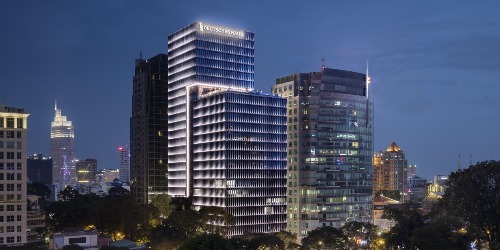NO2 and NO3 blocks, belonging to a real estate project in Bac Tu Liem district in Hanoi, got an EDGE (Excellence in Design for Greater Efficiencies) green certificate earlier this year.

Green buildings are an indispendable trend in Vietnam
This is the first time a social housing project received a certificate of this kind. In people’s thought, green works with high costs must be commercial housing projects rather than products for low-income earners.
The concepts of ‘living green’ and ‘smarthome’ have become better known in Vietnam. However, green houses still are the ‘privilege’ of the rich.
Green buildings, as defined by the Vietnam Green Building Council (VGBC), are those posting high efficiency in energy and material usage, minimising adverse impacts on the environment.
Only a few high-end construction projects have obtained international certificates for green works. Capital House, Phuc Khang, Nam Long, Flamingo Group and Novaland, the realtors pursuing a ‘green work’ strategy, are all major real estate market companies.
Meanwhile, the housing projects for low-income earners mostly use normal building materials.
|
In order to obtain green certificates, LEED (Leadership in Energy and Environmental Design), LOTUS or EDGE, owners of construction works need to prove their capability of reducing energy and water consumption to permitted levels. |
In order to obtain green certificates, LEED (Leadership in Energy and Environmental Design), LOTUS or EDGE, owners of construction works need to prove their capability of reducing energy and water consumption to permitted levels.
With EDGE, for example, the criteria on energy consumption of the projects must be equal to at least 20 percent of typical project according to IFC’s standards.
Customers are the first to benefit from owning a green apartment, because they pay less for power and water bills.
However, a realtor said developing green projects is a big challenge. In Vietnam, green certificates don’t have much importance to consumers.
The World Green Building Trends Report 2018, released by Dodge Data & Analytics, pointed out the green building tendency will continue growing globally.
In Vietnam, according to the Vietnam Green Works Council, the number of green works is on the rise. By the end of 2018, Vietnam had 225 projects registered to be built with LEED and LOTUS standards. Meanwhile, the figure was 42 only one year before.
According to Dang Thanh Long, director of the Vietnam Green Works Council, living in ‘green’ houses improves health, reduces by water and power consumption 30-40 percent, saves 10-15 percent of operation and maintenance costs, and increases the longevity of construction works.
As ‘living green’ is a growing tendency, the demand for green building materials has increased rapidly by 10-12 percent over the last five years.
RELATED NEWS
Green construction materials gaining ground
Vietnam strives to have more green building projects
Kim Chi
 Energy-saving glass, unburnt bricks and nano paint are in demand from owners of construction works who are following the ‘green’ trend.
Energy-saving glass, unburnt bricks and nano paint are in demand from owners of construction works who are following the ‘green’ trend.